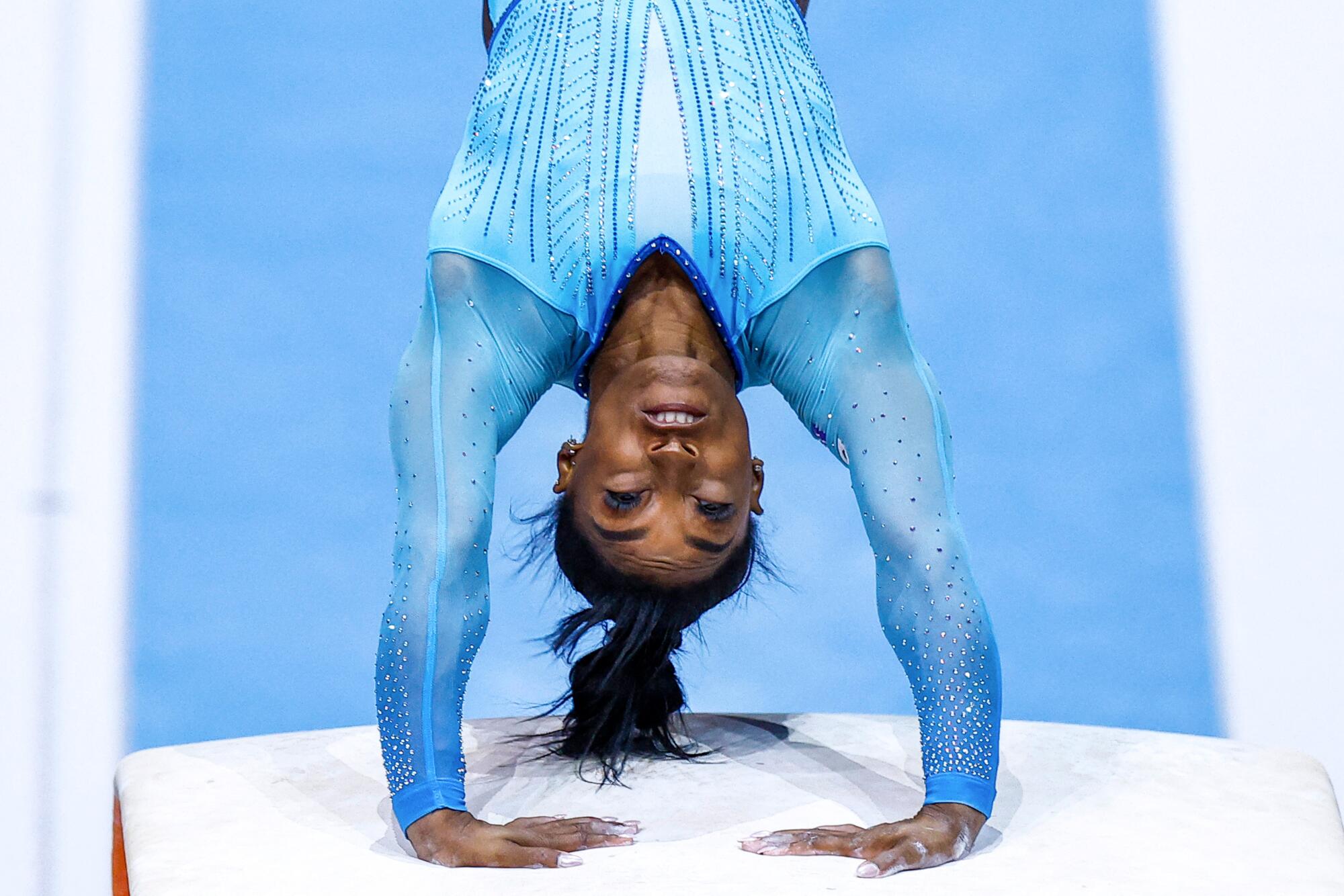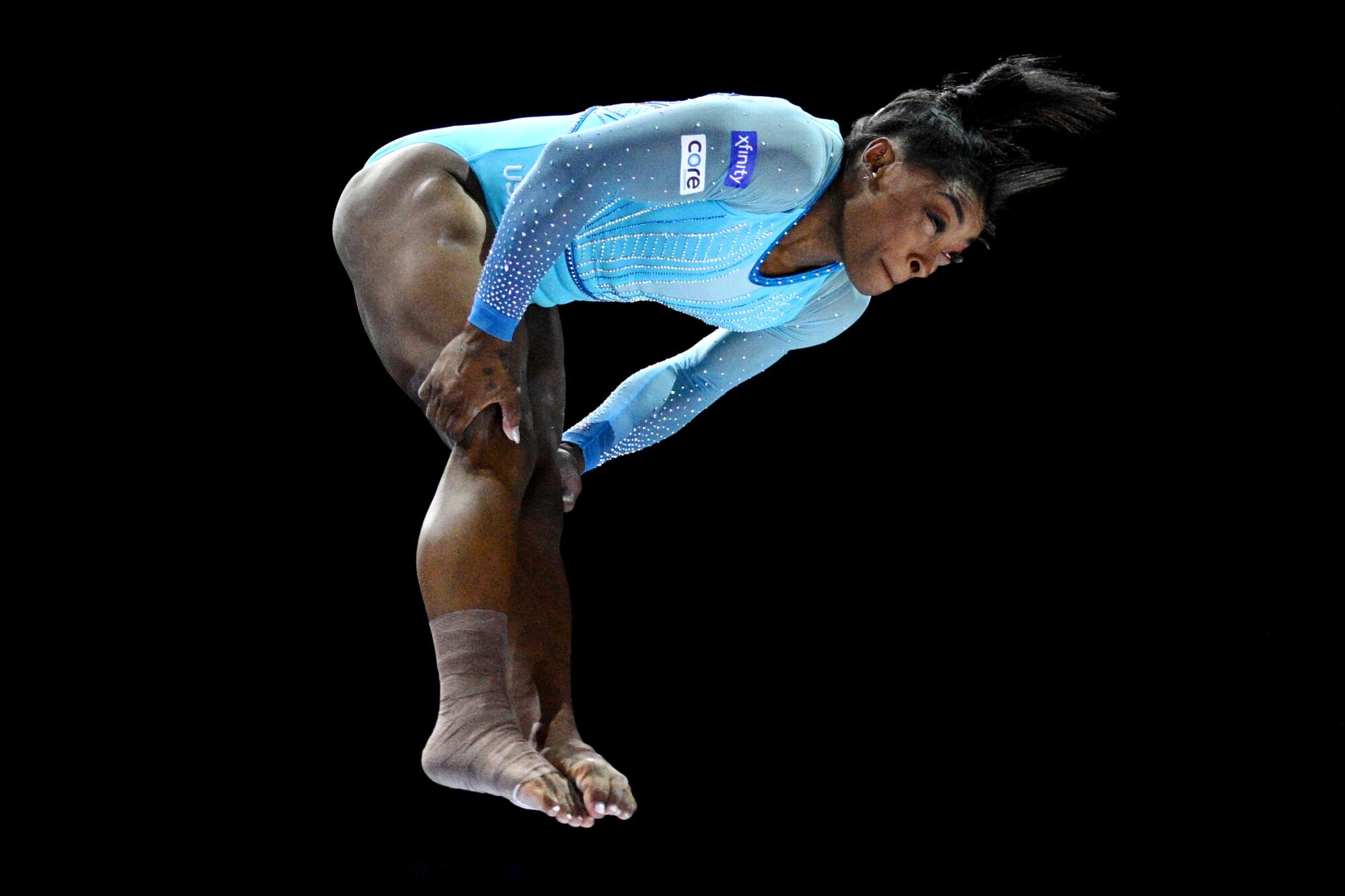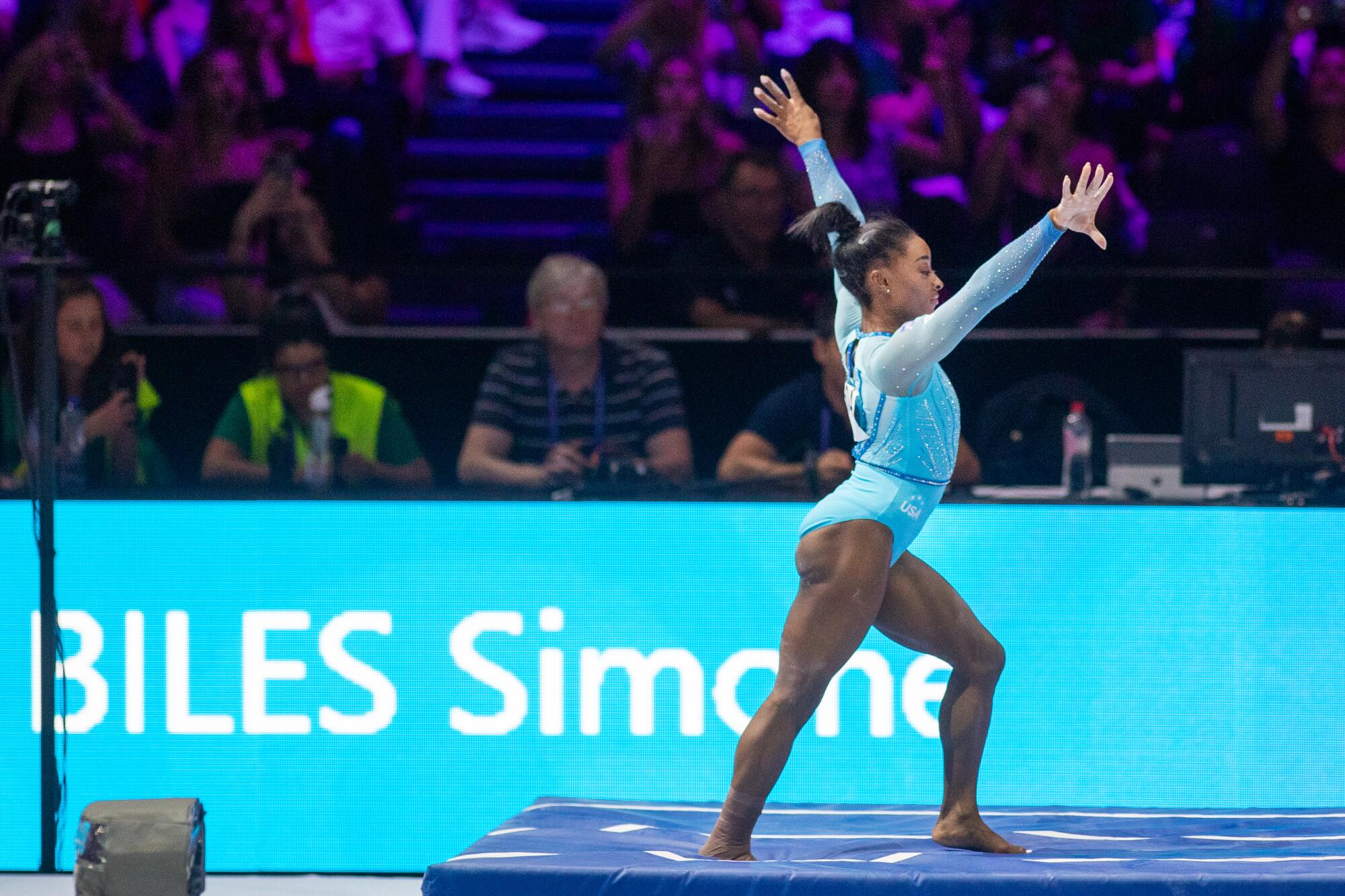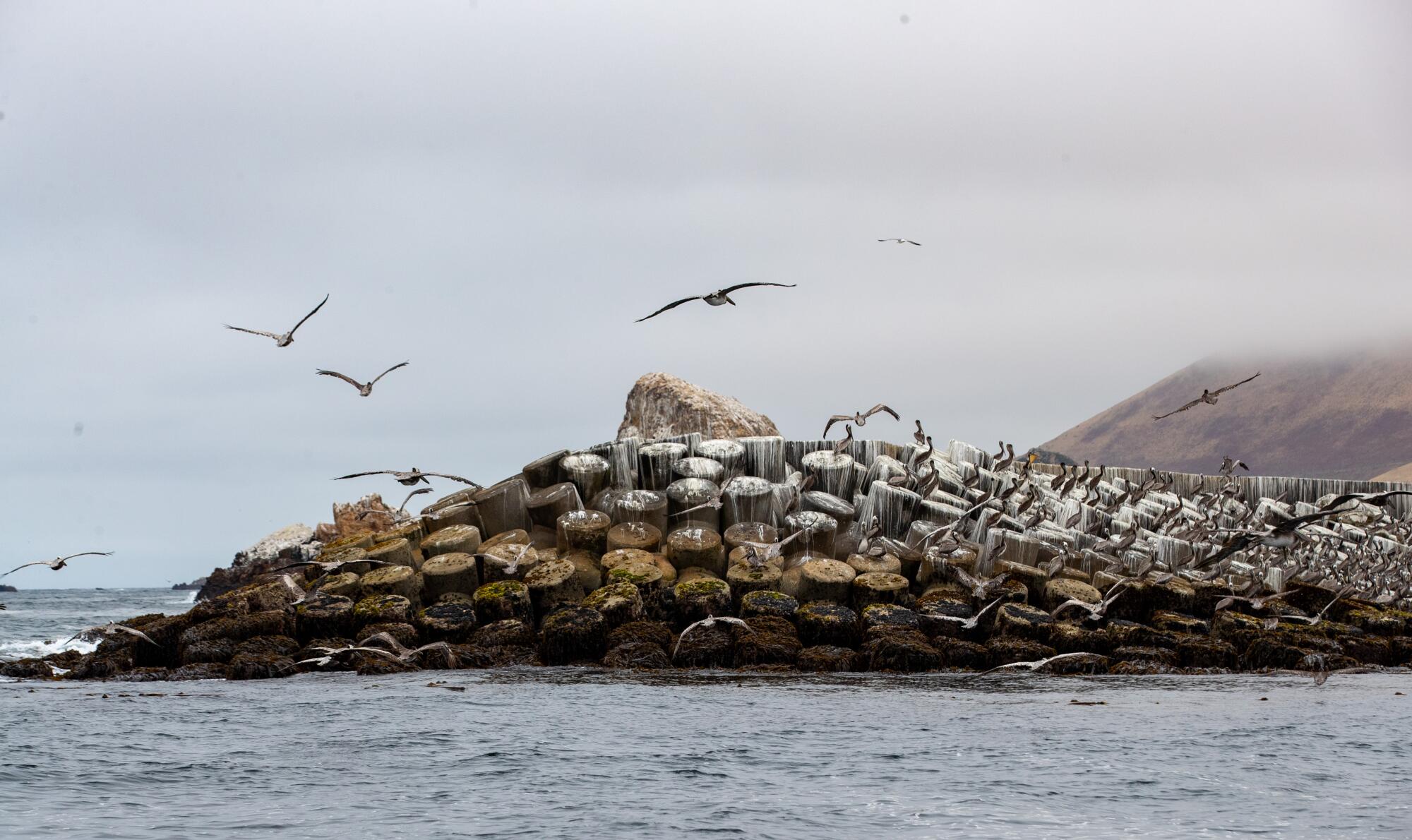Science
Science of Simone: The forces behind her iconic Yurchenko double pike

The most decorated gymnast ever sprints down the vault runway. She tumbles gracefully onto the springboard, flings herself backward onto the vault table and pops off the surface. Soaring through the air, she folds her body in half and grabs the back of her legs for two head-over-heels flips.
The crowd erupts when Simone Biles stomps her feet into the mat.
Another successful Yurchenko double pike.
“It just makes your mouth drop open every time,” said UCLA gymnastics coach Janelle McDonald, who sat in the front row next to the vault landing area at the U.S. Olympic trials, where Biles competed her signature vault.
Of the five skills in the International Gymnastics Federation (FIG) code of points named after Biles, her most recent vault — the Yurchenko double pike — has become the most iconic.
It’s the first major leap in vault innovation for women’s artistic gymnastics in two decades. When leveling up the sky-high event used to mean extra twists, Biles flipped the game upside down. She was the first woman to attempt her double-flipping skill in competition and completed it in international competition for the first time at the 2023 World Championships, earning its name as the Biles II.
“Simone made impossible an opinion with that vault,” NBC analyst John Roethlisberger said on the telecast during the U.S. Olympic trials.
In a sport that blends power and grace, Biles’ Yurchenko double pike is at the center of its own Venn diagram: athletic feat, scientific marvel and artistic genius all in six seconds.
The entry
Biles begins with a sprint down the runway and reaches her hands toward the ground while cartwheeling her legs over her head. The roundoff turns her momentum forward to backward.
(Kenzo Tribouillard / AFP via Getty Images)
The height, the rotation and the landing earn the most gasps from the fans who follow Biles’ every move on the competition floor. But for her peers who continue to marvel at the 27-year-old’s revolutionary talent, the most impressive part of the vault happens before Biles even contacts the table.
“Your Yurchenko entry has to be so technically perfect and so consistent,” said 2016 Olympic gold medalist Kyla Ross. “You have no doubt coming off the table that you’re going to hit the double pike.”
The Yurchenko entry — a roundoff onto the springboard and a back handspring onto the vault table — is named after former Russian gymnast Natalia Yurchenko, who debuted her eponymous skill in 1982. Since the FIG replaced the vault horse — which resembled a pommel horse without handles and was about 5 feet long and 1 foot wide at the top — for a tongue-shaped vault table in 2001, the Yurchenko vault has become more common for elite female gymnasts. Athletes can still harness the power generated from the unique entry while having a larger, safer surface area for their hands.
2024 Paris Summer Olympic Games
Biles begins with a sprint down the runway and reaches her hands toward the ground while cartwheeling her legs over her head. The roundoff turns her momentum forward to backward. Slamming her feet down on the springboard, Biles compresses the springs that then uncoil and transfer energy back into her body as she reaches up and backward for the vault table.
The key to vault liftoff is how Biles contacts the equipment to transfer her momentum.
“Pre-springboard, all of their motion is forwards,” said Emily Kuhn, a physics PhD student at Yale who was a level 10 gymnast. “After the springboard, some of their motion is upwards. And so [the board is] really helpful for converting the rotational energy from that roundoff into an upwards velocity that is used to get the height on the vault.”
In an instant, Biles arches backward toward the vault table. Her body whips back in a lightning-fast handspring that leaves even the best athletes in the world in the dust.
“She gets that power because of how quick-twitched her roundoff-back handspring is, technically speaking,” said 2008 Olympic silver medalist Samantha Peszek. “No one is as quick-twitch as Simone.”
The block

During the block, the moment Biles’ hands strike the table, she extends through her shoulders in a motion that’s barely detectable in real time. The micro-movement lasts a tenth of a second as Biles applies force to the vault that is then returned in equal and opposite measure.
(Kenzo Tribouillard / AFP via Getty Images)
Aly Raisman had a front-row seat to the world’s best vaulters. The two-time Olympian watched 2012 Olympic teammate McKayla Maroney nail a nearly perfect two-and-a-half twisting Yurchenko in the team final. Raisman was also the team captain in 2016 when Biles won Olympic gold on vault. Both standouts shared a key ability that helped them soar above the competition.
“When you look at her elbows on the table, they’re always very straight,” Raisman said. “Their body was so tight when their arms hit the table that it just helps them get so much air.”
The moment Biles’ hands strike the table, she extends through her shoulders in a motion that’s barely detectable in real time. The micro-movement lasts a tenth of a second as Biles applies force to the vault that is then returned in equal and opposite measure. Keeping every muscle contracted during the split second on the table is vital to transferring energy efficiently for maximum height.
“The force gets dispersed in bad form,” said Gina Pongetti, a physical therapist with more than 20 years of experience working with college, national team and elite gymnasts. “[The muscles] are all tight at one time so that nothing gives, nothing buckles. Because of that, all of that force, or as much as possible, goes into the vault [and] goes back to her to transfer to height and rotation.”
NBC estimated that Biles’ feet reach about 12 feet in the air at the peak of her vault when she is upside down.
Former UCLA gymnast Nia Dennis knows the feeling. The three-time U.S. national team member trained a Yurchenko double tuck — with her knees bent and legs pulled toward her chest — into the foam pit during her elite career, eventually stacking up soft mats to be equal to competition height. While she is best known for her viral, energetic floor routines, Dennis loved vault the most. She still recalls the intoxicating feeling of hitting the perfect block that fired her into the air.
“I just felt like a cannon,” Dennis said.
The flips

After Biles blocks off the vault, she is just a projectile.
(Matthias Hangst / Getty Images)
Searching for ways to upgrade her vault difficulty, Dennis wanted to buck the trend of adding additional twists to her Yurchenko. She was always more of a flipper than a twister, and Dennis sometimes landed on her neck from over-rotating her warm-up drills. One day, her coach encouraged her to pull all the way around onto her feet for an additional flip.
“It was just straight power,” Dennis said. “All I had to do was run and close my eyes, for real. Just block really hard, close my eyes really hard and pull really hard.”
For Dennis, the daring skill was fun. Her former UCLA teammate Ross did not share the sentiment.
“I used to like, cry because I was so scared of it,” laughed Ross, who practiced Yurchenko double tucks into the foam pit alongside her longtime club teammate Maroney.
The second flip is what makes the vault so frightening for athletes. Gymnasts can adjust a twisting vault midair by reducing the number of revolutions by halves if they feel something gone awry. There is no safe Plan B between one and two flips.
After Biles blocks off the vault, she is just a projectile, Kuhn emphasized. At that point, there is nothing she can do to change how high she is or her path through the air.
That’s when her proprioception takes over. Biles’ air awareness is “unbelievable,” Pongetti said. The physical therapist, who specializes in treatment, diagnoses and biomechanics in gymnastics, has watched Biles train for years.
While she cannot change her flight path, Biles is an expert in making split-second decisions to rearrange her body midair to change how she will move. If she is too low, she can pull her body into a tighter shape to flip faster. If she is too high, she knows a more open shape can slow down her flip and help avoid over-rotation.
Only that caliber of spatial awareness can make the death-defying skill “safer,” Pongetti said. She would never say it’s “safe.”
“That sets apart the level 10 [gymnast] from the elite,” Pongetti said, “from the Olympian from Simone.”
The landing

Simone Biles of the United States reacts after performing a vault during the 2023 gymnastics world championships in Antwerp, Belgium.
(Tim Clayton / Corbis via Getty Images)
With five skills named for her in the code of points, Biles is at the forefront of the sport’s progression. Peszek remembers when the double-twisting, double back tucks she and 2008 Olympic teammate Shawn Johnson competed were arguably the hardest tumbling passes in the world. Now Biles casually does that skill in combination with a full-twisting front layout.
“It’s really special to see the generations pass the torch and just how they’ve been able to take this sport by storm by creating all these new elements and really pushing the boundaries,” Peszek said. “Seeing her do it so effortlessly, it’s really a work of art to see.”
The Biles II was awarded the highest-difficulty score of any vault by the FIG at 6.4. Astronomical-difficulty scores, which are combined on each event with an execution score out of 10, allow Biles to win competitions by whole numbers as most of her peers fight for half-tenths.
On vault, most of the top medal contenders have difficulty values of 5.4 for the two-and-a-half twisting Yurchenko known as an Amanar or 5.6 for a Cheng, which begins with a roundoff onto the springboard, a half turn onto the vault table and a one-and-a-half twist off.
But Rebeca Andrade could challenge Biles for the crown. The Brazilian Olympic confederation published a YouTube video that featured the Olympic and world vault champion training a triple-twisting Yurchenko. If she lands it in international competition, it will bear her name.
Biles considered the skill as the next Yurchenko progression from an Amanar but has said going for the double flip was safer for her to land. The landing on a twisting flip presents additional challenges, Kuhn said, as gymnasts must absorb rotational forces to stop the twist while also controlling the landing vertically.
A 2013 study estimated that gymnasts absorb 11 times their body weight on landings during competition. The force increases to 18 times body weight if a landing is uneven, a common consequence of twisting elements. What Biles feels when her 4-foot-8 frame is falling from more than two and a half times her height to land the Yurchenko double pike might be even greater, Pongetti said.
“Her quads and her glutes and her hamstrings [and her calves], which otherwise would work to allow her to jump high, work in reverse to slow her down,” Pongetti said. “They are her brakes. … She is so good at not being stiff-legged when she lands.”
Fans seem to hold their breath as Biles floats and flips through the air. At the moment her feet punch into the mat, the crowd exhales with a roar of applause.
Thousands in Paris’ Bercy Arena will see the vault’s official Olympic debut. Millions more will watch internationally.
They’ll see Biles push the boundaries of sport and science in a gravity-defying six-second burst.

Science
Southern California mountain lions recommended for threatened status

The California Department of Fish and Wildlife has recommended granting threatened species status to roughly 1,400 mountain lions roaming the Central Coast and Southern California, pointing to grave threats posed by freeways, rat poison and fierce wildfires.
The determination, released Wednesday, is not the final say but signals a possibility that several clans of the iconic cougars will be listed under the California Endangered Species Act.
It’s a move that supporters say would give the vulnerable animals a chance at recovery, but detractors have argued would make it harder to get rid of lions that pose a safety risk to people and livestock.
The recommendation was “overdue,” Charlton Bonham, director of the state wildlife department, said during a California Fish and Game Commission meeting.
It arrives about six years after the Center for Biological Diversity and Mountain Lion Foundation petitioned the commission to consider listing a half-dozen isolated lion populations that have suffered from being hit by cars, poisoned by rodenticides and trapped by development.
The following year, in 2020 the Commission found the request might be warranted, giving the lions temporary endangered species protections as “candidates” for listing. It also prompted the state wildlife department to put together a report to inform the commission’s final decision.
The next step is for state wildlife commissioners to to vote on the protections, possibly in February.
Brendan Cummings, conservation director for Center for Biological Diversity, hailed the moment as “a good day, not just for mountain lions, but for Californians.”
If the commissioners adopt the recommendation, as he believes they will, then the “final listing of the species removes any uncertainty about the state’s commitment to conserving and recovering these ecologically important, charismatic and well-loved species that are so much a part of California.”
The report recommends listing lions “in an area largely coinciding” with what the petitioners requested, which includes the Santa Ana, San Gabriel, San Bernardino, Santa Monica, Santa Cruz and Tehachapi mountains.
It trims off portions along the northern and eastern borders of what was proposed, including agricultural lands in the Bay Area and a southeastern portion of desert — areas where state experts had no records of lions, according to Cummings.
Officials in the report note that most of the lion groups proposed for listing are contending with a lack of gene flow because urban barriers keep them from reaching one another.
In Southern California, lions have shown deformities from inbreeding, including kinked tails and malformed sperm. There’s an almost 1 in 4 chance, according to research, that mountain lions could become extinct in the Santa Monica and Santa Ana mountains within 50 years.
The late P-22 — a celebrity mountain lion that inhabited Griffith Park – personified the tribulations facing his kind. Rat poison and car collisions battered him from the inside out. He was captured and euthanized in late 2022, deemed too sick to return to the wild because of injuries and infection.
For some species, protections come in the form of stopping chainsaws or bulldozers. But imperiled lions, Cummings said, need their habitats stitched together in the form of wildlife crossings — such as the gargantuan one being built over the 101 Freeway in Agoura Hills. He added that developments that could restrict their movement should get more scrutiny under the proposed protections.
Critics of the effort to list lion populations have said that it will stymie residential and commercial projects.
California is home to roughly 4,170 mountain lions, according to the recent report, but not all are equal in their struggle.
Many lion populations, particularly in northwest coastal forests, are hearty and healthy.
Protections are not being sought for those cats. Some, in fact, would like to see their numbers reduced amid some high-profile conflicts.
Bonham, the director of the state Department of Fish and Wildlife, spoke to concerns about public safety at the recent meeting, alluding to the tragic death of young man who was mauled by a cougar last year in Northern California.
“These are really delicate issues and the conversation I know in the coming years is going to have to grapple with all that,” said Bonham, who will be stepping down this month after nearly 15 years in his role.
California’s lions already enjoy certain protections. In 1990, voters approved a measure that designated them a “specially protected species” and banned hunting them for sport.
Science
California’s last nuclear plant clears major hurdle to power on

California environmental regulators on Thursday struck a landmark deal with Pacific Gas & Electric to extend the life of the state’s last remaining nuclear power plant in exchange for thousands of acres of new land conservation in San Luis Obispo County.
PG&E’s agreement with the California Coastal Commission is a key hurdle for the Diablo Canyon nuclear plant to remain online until at least 2030. The plant was slated to close this year, largely due to concerns over seismic safety, but state officials pushed to delay it — saying the plant remains essential for the reliable operation of California’s electrical grid. Diablo Canyon provides nearly 9% of the electricity generated in the state, making it the state’s single largest source.
The Coastal Commission voted 9-3 to approve the plan, settling the fate of some 12,000 acres that surround the power plant as a means of compensation for environmental harm caused by its continued operation.
Nuclear power does not emit greenhouse gases. But Diablo Canyon uses an estimated 2.5 billion gallons of ocean water each day to absorb heat in a process known as “once-through cooling,” which kills an estimated two billion or more marine organisms each year.
Some stakeholders in the region celebrated the conservation deal, while others were disappointed by the decision to trade land for marine impacts — including a Native tribe that had hoped the land would be returned to them. Diablo Canyon sits along one of the most rugged and ecologically rich stretches of the California coast.
Under the agreement, PG&E will immediately transfer a 4,500-acre parcel on the north side of the property known as the “North Ranch” into a conservation easement and pursue transfer of its ownership to a public agency such as the California Department of Parks and Recreation, a nonprofit land conservation organization or tribe. A purchase by State Parks would result in a more than 50% expansion of the existing Montaña de Oro State Park.
PG&E will also offer a 2,200-acre parcel on the southern part of the property known as “Wild Cherry Canyon” for purchase by a government agency, nonprofit land conservation organization or tribe. In addition, the utility will provide $10 million to plan and manage roughly 25 miles of new public access trails across the entire property.
“It’s going to be something that changes lives on the Central Coast in perpetuity,” Commissioner Christopher Lopez said at the meeting. “This matters to generations that have yet to exist on this planet … this is going to be a place that so many people mark in their minds as a place that transforms their lives as they visit and recreate and love it in a way most of us can’t even imagine today.”
Critically, the plan could see Diablo Canyon remain operational much longer than the five years dictated by Thursday’s agreement. While the state Legislature only authorized the plant to operate through 2030, PG&E’s federal license renewal would cover 20 years of operations, potentially keeping it online until 2045.
Should that happen, the utility would need to make additional land concessions, including expanding an existing conservation area on the southern part of the property known as the “South Ranch” to 2,500 acres. The plan also includes rights of first refusal for a government agency or a land conservation group to purchase the entirety of the South Ranch, 5,000 acres, along with Wild Cherry Canyon — after 2030.

Pelicans along the concrete breakwater at Pacific Gas and Electric’s Diablo Canyon Power Plant
(Brian van der Brug/Los Angeles Times)
Many stakeholders were frustrated by the carve-out for the South Ranch, but still saw the agreement as an overall victory for Californians.
“It is a once in a lifetime opportunity,” Sen. John Laird (D-Santa Cruz) said in a phone call ahead of Thursday’s vote. “I have not been out there where it has not been breathtakingly beautiful, where it is not this incredible, unique location, where you’re not seeing, for much of it, a human structure anywhere. It is just one of those last unique opportunities to protect very special land near the California coast.”
Others, however, described the deal as disappointing and inadequate.
That includes many of the region’s Native Americans who said they felt sidelined by the agreement. The deal does not preclude tribal groups from purchasing the land in the future, but it doesn’t guarantee that or give them priority.
The yak titʸu titʸu yak tiłhini Northern Chumash Tribe of San Luis Obispo County and Region, which met with the Coastal Commission several times in the lead-up to Thursday’s vote, had hoped to see the land returned to them.
Scott Lanthrop is a member of the tribe’s board and has worked on the issue for several years.
“The sad part is our group is not being recognized as the ultimate conservationist,” he told The Times. “Any normal person, if you ask the question, would you rather have a tribal group that is totally connected to earth and wind and water, or would you like to have some state agency or gigantic NGO manage this land, I think the answer would be, ‘Hey, you probably should give it back to the tribe.’”
Tribe chair Mona Tucker said she fears that free public access to the land could end up harming it instead of helping it, as the Coastal Commission intends.
“In my mind, I’m not understanding how taking the land … is mitigation for marine life,” Tucker said. “It doesn’t change anything as far as impacts to the water. It changes a lot as far as impacts to the land.”

Montaña de Oro State Park.
(Christopher Reynolds / Los Angeles Times)
The deal has been complicated by jurisdictional questions, including who can determine what happens to the land. While PG&E owns the North Ranch parcel that could be transferred to State Parks, the South Ranch and Wild Cherry Canyon are owned by its subsidiary, Eureka Energy Company.
What’s more, the California Public Utilities Commission, which regulates utilities such as PG&E, has a Tribal Land Transfer Policy that calls for investor-owned power companies to transfer land they no longer want to Native American tribes.
In the case of Diablo Canyon, the Coastal Commission became the decision maker because it has the job of compensating for environmental harm from the facility’s continued operation. Since the commission determined Diablo’s use of ocean water can’t be avoided, it looked at land conservation as the next best method.
This “out-of-kind” trade-off is a rare, but not unheard of way of making up for the loss of marine life. It’s an approach that is “feasible and more likely to succeed” than several other methods considered, according to the commission’s staff report.
“This plan supports the continued operation of a major source of reliable electricity for California, and is in alignment with our state’s clean energy goals and focus on coastal protection,” Paula Gerfen, Diablo Canyon’s senior vice president and chief nuclear officer, said in a statement.
But Assemblymember Dawn Addis (D-Morro Bay) said the deal was “not the best we can do” — particularly because the fate of the South Ranch now depends on the plant staying in operation beyond 2030.
“I believe the time really is now for the immediate full conservation of the 12,000 [acres], and to bring accountability and trust back for the voters of San Luis Obispo County,” Addis said during the meeting.
There are also concerns about the safety of continuing to operate a nuclear plant in California, with its radioactive waste stored in concrete casks on the site. Diablo Canyon is subject to ground shaking and earthquake hazards, including from the nearby Hosgri Fault and the Shorline Fault, about 2.5 miles and 1 mile from the facility, respectively.
PG&E says the plant has been built to withstand hazards. It completed a seismic hazard assessment in 2024, and determined Diablo Canyon is safe to continue operation through 2030. The Coastal Commission, however, found if the plant operates longer, it would warrant further seismic study.
A key development for continuing Diablo Canyon’s operation came in 2022 with Senate Bill 846, which delayed closure by up to five additional years. At the time, California was plagued by rolling blackouts driven extreme heat waves, and state officials were growing wary about taking such a major source of power offline.
But California has made great gains in the last several years — including massive investments in solar energy and battery storage — and some questioned whether the facility is still needed at all.
Others said conserving thousands of acres of land still won’t make up for the harms to the ocean.
“It is unmitigatable,” said David Weisman, executive director of the nonprofit Alliance for Nuclear Responsibility. He noted that the Coastal Commission’s staff report says it would take about 99 years to balance the loss of marine life with the benefits provided by 4,500 acres of land conservation. Twenty more years of operation would take about 305 years to strike that same balance.
But some pointed out that neither the commission nor fisheries data find Diablo’s operations cause declines in marine life. Ocean harm may be overestimated, said Seaver Wang, an oceanographer and the climate and energy director at the Breakthrough Institute, a Berkeley-based research center.
In California’s push to transition to clean energy, every option comes with downsides, Wang said. In the case of nuclear power — which produces no greenhouse gas emissions — it’s all part of the trade off, he said.
“There’s no such thing as impacts-free energy,” he said.
The Coastal Commission’s vote is one of the last remaining obstacles to keeping the plant online. PG&E will also need a final nod from the Regional Water Quality Control Board, which decides on a pollution discharge permit in February.
The federal Nuclear Regulatory Commission will also have to sign off on Diablo’s extension.
Science
In search for autism’s causes, look at genes, not vaccines, researchers say

Earlier this year, Health and Human Services Secretary Robert F. Kennedy Jr. pledged that the search for autism’s cause — a question that has kept researchers busy for the better part of six decades — would be over in just five months.
“By September, we will know what has caused the autism epidemic, and we’ll be able to eliminate those exposures,” Kennedy told President Trump during a Cabinet meeting in April.
That ambitious deadline has come and gone. But researchers and advocates say that Kennedy’s continued fixation on autism’s origins — and his frequent, inaccurate claims that childhood vaccines are somehow involved — is built on fundamental misunderstandings of the complex neurodevelopmental condition.
Even after more than half a century of research, no one yet knows exactly why some people have autistic traits and others do not, or why autism spectrum disorder looks so different across the people who have it. But a few key themes have emerged.
Researchers believe that autism is most likely the result of a complex set of interactions between genes and the environment that unfold while a child is in the womb. It can be passed down through families, or originate with a spontaneous gene mutation.
Environmental influences may indeed play a role in some autism cases, but their effect is heavily influenced by a person’s genes. There is no evidence for a single trigger that causes autism, and certainly not one a child encounters after birth: not a vaccine, a parenting style or a post-circumcision Tylenol.
“The real reason why it’s complicated, the more fundamental one, is that there’s not a single cause,” said Irva Hertz-Picciotto, a professor of public health science and director of the Environmental Health Sciences Center at UC Davis. “It’s not a single cause from one person to the next, and not a single cause within any one person.”
Kennedy, an attorney who has no medical or scientific training, has called research into autism’s genetics a “dead end.” Autism researchers counter that it’s the only logical place to start.
“If we know nothing else, we know that autism is primarily genetic,” said Joe Buxbaum, a molecular neuroscientist who directs the Seaver Autism Center for Research and Treatment at the Icahn School of Medicine at Mount Sinai. “And you don’t have to actually have the exact genes [identified] to know that something is genetic.”
Some neurodevelopment disorders arise from a difference in a single gene or chromosome. People with Down syndrome have an extra copy of chromosome 21, for example, and Fragile X syndrome results when the FMR1 gene isn’t expressed.
Autism in most cases is polygenetic, which means that multiple genes are involved, with each contributing a little bit to the overall picture.
Researchers have found hundreds of genes that could be associated with autism; there may be many more among the roughly 20,000 in the human genome.
In the meantime, the strongest evidence that autism is genetic comes from studies of twins and other sibling groups, Buxbaum and other researchers said.
The rate of autism in the U.S. general population is about 2.8%, according to a study published last year in the journal Pediatrics. Among children with at least one autistic sibling, it’s 20.2% — about seven times higher than the general population, the study found.
Twin studies reinforce the point. Both identical and fraternal twins develop in the same womb and are usually raised in similar circumstances in the same household. The difference is genetic: identical twins share 100% of their genetic information, while fraternal twins share about 50% (the same as nontwin siblings).
If one fraternal twin is autistic, the chance that the other twin is also autistic is about 20%, or about the same as it would be for a nontwin sibling.
But if one in a pair of identical twins is autistic, the chance that the other twin is also autistic is significantly higher. Studies have pegged the identical twin concurrence rate anywhere from 60% to 90%, though the intensity of the twins’ autistic traits may differ significantly.
Molecular genetic studies, which look at the genetic information shared between siblings and other blood relatives, have found similar rates of genetic influence on autism, said Dr. John Constantino, a professor of pediatrics, psychiatry and behavioral sciences at the Emory University School of Medicine and chief of behavioral and mental health at Children’s Healthcare of Atlanta.
Together, he said, “those studies have indicated that a vast share of the causation of autism can be traced to the effects of genetic influences. That is a fact.”
Buxbaum compares the heritability of autism to the heritability of height, another polygenic trait.
“There’s not one gene that’s making you taller or shorter,” Buxbaum said. Hundreds of genes play a role in where you land on the height distribution curve. A lot of those genes run in families — it’s not unusual for very tall people, for example, to have very tall relatives.
But parents pass on a random mix of their genes to their children, and height distribution across a group of same-sex siblings can vary widely. Genetic mutations can change the picture. Marfan syndrome, a condition caused by mutations in the FBN1 gene, typically makes people grow taller than average. Hundreds of genetic mutations are associated with dwarfism, which causes shorter stature.
Then once a child is born, external factors such as malnutrition or disease can affect the likelihood that they reach their full height potential.
So genes are important. But the environment — which in developmental science means pretty much anything that isn’t genetics, including parental age, nutrition, air pollution and viruses — can play a major role in how those genes are expressed.
“Genetics does not operate in a vacuum, and at the same time, the impact of the environment on people is going to depend on a person’s individual genetics,” said Brian K. Lee, a professor of epidemiology and biostatistics at Drexel University who studies the genetics of developmental disorders.
Unlike the childhood circumstances that can affect height, the environmental exposures associated with autism for the most part take place in utero.
Researchers have identified multiple factors linked to increased risks of the disorder, including older parental age, infant prematurity and parental exposure to air pollution and industrial solvents.
Investigations into some of these linkages were among the more than 50 autism-related studies whose funding Kennedy has cut since taking office, a ProPublica investigation found. In contrast, no credible study has found links between vaccines and autism — and there have been many.
One move from the Department of Health and Human Services has been met with cautious optimism: even as Kennedy slashed funding to other research projects, the department in September announced a $50-million initiative to explore the interactions of genes and environmental factors in autism, which has been divided among 13 different research groups at U.S. universities, including UCLA and UC San Diego.
The department’s selection of well-established, legitimate research teams was met with relief by many autism scientists.
But many say they fear that such decisions will be an anomaly under Kennedy, who has repeatedly rejected facts that don’t conform to his preferred hypotheses, elevated shoddy science and muddied public health messaging on autism with inaccurate information.
Disagreements are an essential part of scientific inquiry. But the productive ones take place in a universe of shared facts and build on established evidence.
And when determining how to spend limited resources, researchers say, making evidence-based decisions is vital.
“There are two aspects of these decisions: Is it a reasonable expenditure based on what we already know? And if you spend money here, will you be taking money away from HHS that people are in desperate need of?” Constantino said. “If you’re going to be spending money, you want to do that in a way that is not discarding what we already know.”
-

 Alaska6 days ago
Alaska6 days agoHowling Mat-Su winds leave thousands without power
-
Ohio1 week ago
Who do the Ohio State Buckeyes hire as the next offensive coordinator?
-

 Texas6 days ago
Texas6 days agoTexas Tech football vs BYU live updates, start time, TV channel for Big 12 title
-

 Washington3 days ago
Washington3 days agoLIVE UPDATES: Mudslide, road closures across Western Washington
-

 Iowa5 days ago
Iowa5 days agoMatt Campbell reportedly bringing longtime Iowa State staffer to Penn State as 1st hire
-

 Miami, FL6 days ago
Miami, FL6 days agoUrban Meyer, Brady Quinn get in heated exchange during Alabama, Notre Dame, Miami CFP discussion
-

 Cleveland, OH5 days ago
Cleveland, OH5 days agoMan shot, killed at downtown Cleveland nightclub: EMS
-
World5 days ago
Chiefs’ offensive line woes deepen as Wanya Morris exits with knee injury against Texans

















